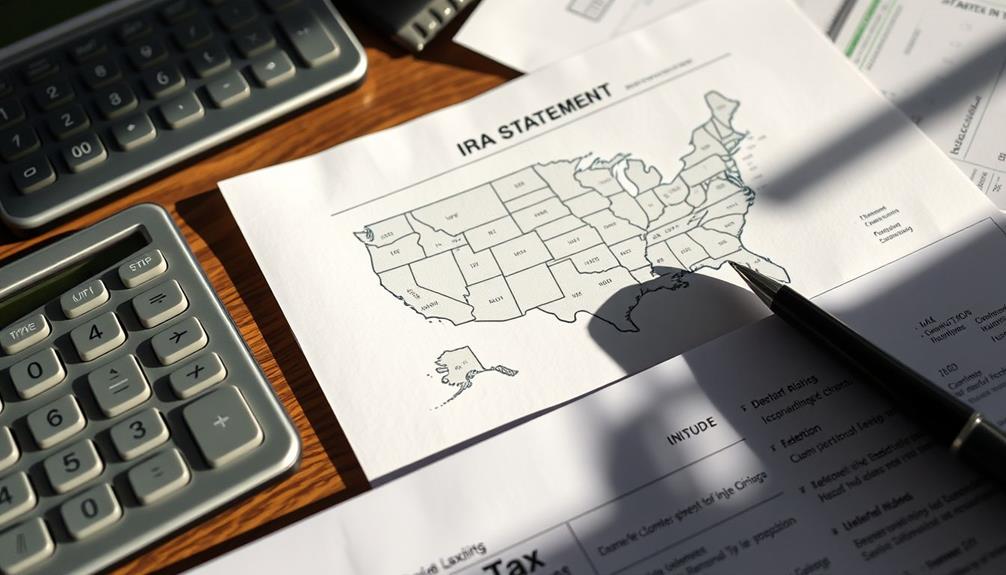When preparing for retirement in North Dakota, it is crucial to align your IRAs with state-specific benefits. Taking advantage of options such as the NDPERS Defined Benefit and Defined Contribution plans can provide you with a steady income or investment flexibility. North Dakota does not impose state taxes on Social Security and Traditional IRA distributions, helping to preserve your retirement income. By contributing to both NDPERS and IRAs, you can increase your savings potential. Making the most of your contributions, especially if you are over 50, can have a significant impact on your financial future. Be sure to explore ways to optimize your strategy and utilize valuable resources to make well-informed decisions about your retirement journey.
Key Takeaways
- North Dakota offers favorable tax conditions, with no state tax on Traditional IRA distributions, enhancing retirement income preservation.
- NDPERS provides flexible retirement plans, allowing contributions to both employer-sponsored plans and IRAs for maximized savings potential.
- Contributions to Traditional IRAs may be tax-deductible, further reducing taxable income and benefiting overall retirement strategies.
- The MSS platform offers personalized benefit estimates and resources to optimize IRA contributions alongside NDPERS benefits.
- Educational workshops and financial advisor access through NDPERS assist in tailoring retirement plans to individual needs.
Overview of Retirement Planning

When you think about retirement planning in North Dakota, it's essential to understand the options available to you. The North Dakota Public Employees Retirement System (NDPERS) provides structured retirement planning through both Defined Benefit and Defined Contribution plans for state employees. These plans are designed to guarantee you have a secure financial future.
To enhance your retirement savings, you can also consider Individual Retirement Accounts (IRAs). In 2024, you can contribute up to $7,000 if you're under 50, or $8,000 if you're 50 or older. This flexibility allows you to diversify your retirement savings strategies considerably.
Moreover, North Dakota retirees enjoy favorable tax benefits, with no taxation on Social Security benefits and exemptions on other types of retirement income. This means more of your hard-earned money stays in your pocket during retirement.
As an NDPERS member, you can utilize the Member Self Service (MSS) platform to access personalized benefit estimates and resources. This tool can help you make informed decisions about your retirement planning, assuring you're well-prepared for the future.
Take advantage of these resources to secure your financial well-being.
Understanding Individual Retirement Accounts

Retirement planning in North Dakota isn't complete without considering Individual Retirement Accounts (IRAs), which play an essential role in boosting your savings. In 2024, you can contribute up to $7,000 if you're under 50 and $8,000 if you're 50 or older.
Understanding the differences between Traditional and Roth IRAs is vital for your retirement strategy. Additionally, exploring options like a Gold IRA can help you protect against inflation and market downturns, offering a way to diversify your portfolio.
With a Traditional IRA, your contributions might be tax-deductible based on your income, allowing you to lower your taxable income now. On the other hand, Roth IRAs provide tax-free withdrawals in retirement, which can be especially appealing if you expect to be in a higher tax bracket later.
North Dakota offers a favorable tax environment since it doesn't tax distributions from Traditional IRAs, making it an attractive option for retirees.
Additionally, if you're interested in diversifying your retirement savings, you might explore Gold IRAs, which allow investments in precious metals.
North Dakota Public Employees Retirement System

The North Dakota Public Employees Retirement System (NDPERS) offers you flexible retirement plan options, including both Defined Benefit and Defined Contribution plans.
You can easily access personalized benefit estimates through the Member Self Service platform, making your planning more straightforward.
Understanding your contribution options and how they impact your future benefits is key to securing your financial future.
NDPERS Plan Options
Steering your options within the North Dakota Public Employees Retirement System (NDPERS) can feel overwhelming, but understanding the two main plan choices is essential for effective retirement planning. You have the Defined Benefit plan, which guarantees monthly retirement benefits for life, and the Defined Contribution plan, where your account balance depends on your investments and contributions from both you and your employer.
| Plan Type | Key Features |
|---|---|
| Defined Benefit Plan | Guaranteed monthly benefits, 6.00% interest, lifetime payouts. |
| Defined Contribution Plan | Investment choices, fluctuating account balance, withdrawals allowed under specific conditions. |
As an NDPERS member, you can also enhance your retirement strategy by contributing to an Individual Retirement Account (IRA). For 2024, you can contribute up to $7,000 if you're under 50 and $8,000 if you're 50 or older. Plus, through the Member Self Service platform, you can access personalized benefit estimates and resources, helping you make informed decisions regarding your retirement benefits.
Benefit Estimation Tools
Steering your retirement planning is much easier with the right benefit estimation tools at your disposal. The North Dakota Public Employees Retirement System (NDPERS) offers a robust Member Self Service (MSS) platform where you can access personalized monthly benefit estimates for both Defined Benefit and Defined Contribution plans. This feature allows you to assess your retirement savings program effectively, ensuring you make informed financial decisions.
By utilizing these benefit estimation tools, you'll gain a clearer picture of your expected benefits and savings trajectory. The MSS platform not only tracks your contributions and service credits but also provides essential data to enhance your retirement readiness.
If you need more detailed information, you can always request alternative estimates by filling out the SFN 53603 form, which helps you explore different retirement options.
Incorporating these resources into your planning process can greatly improve your understanding of the benefits available to you. By staying informed and proactive, you can navigate your retirement journey with confidence and clarity, ensuring you're well-prepared for the future.
Contribution Flexibility Insights
Understanding your contribution options is essential for maximizing your retirement savings. The North Dakota Public Employees Retirement System (NDPERS) allows you to contribute to both employer-sponsored plans and IRAs, which can greatly enhance your retirement income.
For 2024, the contribution limits for IRAs are set at $7,000 for those under 50 and $8,000 for individuals aged 50 and older. This flexibility gives you the opportunity to boost your retirement savings.
Utilizing the Member Self Service (MSS) platform, you can access personalized benefit estimates and resources to optimize your IRA contributions alongside your NDPERS benefits. It's important to understand how these contributions work together to guarantee you're making the most of your retirement options.
Additionally, North Dakota's tax advantages for traditional IRA distributions mean you'll reduce your tax liability in retirement, which is an added incentive for contributing.
Defined Benefit Vs. Defined Contribution

When considering retirement options, it's essential to understand the differences between Defined Benefit and Defined Contribution plans.
Defined Benefit plans offer predictable monthly payments, while Defined Contribution plans depend on your contributions and market performance.
Benefit Structures Comparison
Many people find themselves weighing the benefits of Defined Benefit and Defined Contribution plans when planning for retirement in North Dakota.
Defined Benefit plans provide a guaranteed monthly income based on a specific formula considering your salary and years of service. This offers financial stability throughout retirement, ensuring you know what to expect each month.
In contrast, Defined Contribution plans, like those offered by NDPERS, depend on contributions from both you and your employer. Your retirement benefit will vary based on investment performance and market fluctuations, which means you shoulder more financial risk.
With Defined Benefit plans, you can access personalized monthly benefit estimates through the NDPERS Member Self Service platform.
Defined Contribution participants, however, can track their account balances and investment options. While Defined Benefit plans typically offer lower financial risk, Defined Contribution plans might appeal if you prefer to have control over your retirement savings.
Both plans allow contributions to IRAs, with limits set for 2024 at $7,000 for those under 50 and $8,000 for those aged 50 and older, giving you additional avenues for retirement savings that complement your primary plan.
Contribution Flexibility Differences
While both Defined Benefit and Defined Contribution plans play essential roles in retirement planning, their contribution flexibility differs markedly. Defined Benefit plans offer you a predetermined monthly benefit for life, providing financial security without needing you to make active contributions after retirement. This structure guarantees you know exactly what you'll receive, eliminating uncertainty.
On the other hand, Defined Contribution plans, like those from NDPERS, depend on both employee and employer contributions, as well as investment performance. This means the final retirement benefit can fluctuate considerably based on market conditions, leaving the outcome less predictable.
In 2024, both plans allow contributions to Individual Retirement Accounts (IRAs), with contribution limits of $7,000 for those under 50 and $8,000 for those 50 and older. This flexibility enhances your overall retirement savings potential.
Managing your investments in a Defined Contribution plan is vital, as your financial security hinges on your ability to navigate these choices effectively. By accessing personalized benefit estimates through the Member Self Service (MSS) platform, you can better understand these differences and plan for a more secure retirement.
Risk and Reward Analysis
Understanding the risk and reward dynamics between Defined Benefit and Defined Contribution plans is essential for your retirement strategy. Each option presents unique advantages and challenges that can impact your retirement income.
- Defined Benefit plans guarantee a fixed monthly benefit for life, providing stability and reducing investment risk.
- Defined Contribution plans, like those from NDPERS, tie your retirement income to your account balance and market performance, exposing you to higher risks and potential losses during downturns.
- While Defined Benefit plans accrue service credit at a guaranteed 6.00% interest, ensuring predictable growth, Defined Contribution plans depend on variable market returns that can be uncertain.
- Participants in Defined Contribution plans can manage their investments, which offers the potential for higher returns but requires a solid understanding of market dynamics and investment strategies.
Ultimately, the choice between these plans often depends on your individual risk tolerance. If you prefer stability and predictability, Defined Benefit plans may be more appealing.
On the other hand, if you're willing to assume investment risk for potentially greater rewards, Defined Contribution plans, along with Individual Retirement Accounts (IRAs), might suit your needs better.
Contribution Limits and Tax Advantages

When planning for retirement, grasping the contribution limits and tax advantages available in North Dakota can greatly impact your savings strategy. For 2024, you can contribute up to $7,000 to IRAs if you're under 50, and up to $8,000 if you're 50 or older. This increased contribution limit enhances your retirement savings potential.
North Dakota provides unique tax advantages. Traditional IRA distributions aren't taxed, reducing your tax liability when you withdraw funds in retirement. Additionally, contributions to Traditional IRAs may be tax-deductible, allowing for tax-efficient savings growth until you start withdrawing. Meanwhile, Roth IRAs provide tax-free withdrawals under specific conditions, making them a valuable option.
The state also offers tax credits to incentivize retirement savings contributions, further amplifying the benefits of participating in IRAs.
Here's a quick overview of these aspects:
| Account Type | Contribution Limit | Tax Advantage |
|---|---|---|
| Traditional IRA | $7,000 / $8,000 | Tax-deductible contributions |
| Roth IRA | $7,000 / $8,000 | Tax-free withdrawals |
| North Dakota Tax Credit | Varies | Incentivizes retirement savings |
Understanding these factors can help optimize your retirement plan.
State-Specific Retirement Benefits

North Dakota offers several state-specific retirement benefits that can greatly enhance your retirement strategy. By leveraging these options, you can maximize your retirement savings and enjoy favorable tax conditions.
Here are four key benefits to evaluate:
- Tax Advantages: North Dakota doesn't tax traditional IRA distributions, giving you a significant tax advantage when accessing your retirement savings.
- NDPERS Plans: The North Dakota Public Employees Retirement System (NDPERS) provides both Defined Benefit and Defined Contribution plans, allowing state employees to choose a retirement savings program that fits their needs.
- IRA Contributions: Even if you participate in employer-sponsored retirement plans, you can still contribute to Individual Retirement Accounts (IRAs). For 2024, the contribution limits are $7,000 for those under 50 and $8,000 for those 50 and older.
- Social Security and Retirement Income: Retirees benefit from no state taxation on Social Security and exemptions on certain retirement incomes, further enhancing your overall retirement benefits.
Integrating IRAS With NDPERS

When you're planning for retirement in North Dakota, integrating your IRAs with your NDPERS benefits can greatly boost your savings.
You can take advantage of NDPERS' flexible plan options and make additional contributions to your IRA, especially if you're 50 or older.
Plus, with favorable tax conditions, your retirement funds can grow even more efficiently.
NDPERS Plan Options
Integrating your Individual Retirement Accounts (IRAs) with NDPERS plans can greatly enhance your retirement savings strategy. The North Dakota Public Employees Retirement System (NDPERS) offers both Defined Benefit and Defined Contribution plans, which you can complement with your IRAs.
Here are four key benefits to weigh:
- Contribution Flexibility: You can still contribute to your IRAs while participating in NDPERS, with limits of $7,000 for those under 50 and $8,000 for those 50 and older as of 2024.
- Diversification: By contributing to IRAs, including Gold IRAs, you diversify your retirement portfolio, which can provide additional security and growth potential alongside NDPERS benefits.
- Tax Advantages: North Dakota has no taxation on traditional IRA distributions, making your retirement funds work harder for you when integrated with NDPERS.
- Informed Decisions: Utilize the Member Self Service (MSS) platform for personalized benefit estimates and resources that help you navigate your retirement planning effectively.
IRA Contribution Benefits
Combining your Individual Retirement Accounts (IRAs) with NDPERS benefits can greatly enhance your retirement planning. In 2024, you can contribute up to $7,000 to your IRA if you're under 50, or $8,000 if you're 50 or older. This flexibility allows you to boost your retirement savings plan alongside your NDPERS benefits.
North Dakota's tax advantages further sweeten the deal, as the state doesn't tax traditional IRA distributions. This means you can enjoy increased tax efficiency and maximize your savings potential. Additionally, the tax deductibility of traditional IRA contributions may be available based on your income, which can greatly benefit your financial strategy.
As an NDPERS member, you can access personalized estimates of your retirement benefits, making it easier to integrate these with your IRA contributions. This integration not only enhances your overall retirement savings but also accommodates both Defined Benefit and Defined Contribution preferences.
Tax Advantages Explained
Understanding the tax advantages of integrating IRAs with your NDPERS benefits is essential for maximizing your retirement savings. By leveraging these benefits, you can optimize your financial strategy in retirement.
Here are four key tax advantages to evaluate:
- No State Tax on Distributions: North Dakota doesn't tax traditional IRA distributions, allowing you to keep more of your retirement income.
- Tax-Deductible Contributions: Depending on your income levels, contributions to traditional IRAs might be tax-deductible, which can provide immediate tax benefits and boost your overall retirement savings.
- Increased Contribution Limits: For 2024, you can contribute up to $7,000 to your IRAs if you're under 50, and $8,000 if you're 50 or older, which complements your NDPERS benefits.
- Roth IRA Flexibility: Roth IRAs allow for tax-free withdrawals under certain conditions, offering a tax-efficient supplement for those in the NDPERS Defined Contribution plan.
Compliance With State Retirement Mandates

As you navigate the complexities of retirement planning in North Dakota, compliance with state retirement mandates is crucial for your business's success. Employers with five or more employees must register for state-mandated retirement plans, with specific deadlines based on your workforce size. Not adhering to these requirements can lead to hefty penalties, potentially reaching $5,000 annually for larger employers.
Here's a quick overview of key compliance elements:
| Requirement | Details |
|---|---|
| Employee Count | Register if you have five or more employees |
| Registration Deadlines | Varies by number of employees |
| Automatic Enrollment | Enroll eligible employees automatically |
| Opt-Out Option | Employees can opt out of the state plan |
| Compliance Support | Utilize resources from the North Dakota Public Employees Retirement System (NDPERS) |
Understanding these mandates helps you avoid penalties and guarantee you're offering retirement savings options to your eligible employees. By staying informed and compliant, you'll not only protect your business but also contribute to your employees' financial security in retirement.
Resources for Retirement Planning

When it comes to retirement planning in North Dakota, you've got a wealth of resources at your fingertips. The state's Public Employees Retirement System (NDPERS) is a crucial asset, offering tools and support to help you maximize your retirement savings.
Here are four key resources you should consider:
- Member Self Service (MSS): This platform allows you to track your contributions and service credits, ensuring you stay informed about your progress.
- Educational Workshops: NDPERS provides workshops that clarify retirement options and enhance your understanding of benefits and strategies, empowering you to make informed decisions.
- One-on-One Consultations: Meet with NDPERS representatives to tailor your retirement planning to your specific needs, integrating your Individual Retirement Accounts (IRAs) and any state-sponsored retirement plans.
- Personalized Benefit Estimates: Use the SFN 53603 form to request estimates that aid in effective retirement preparation, allowing you to visualize your financial future.
With financial advisors and NDPERS at your side, you can confidently navigate your retirement planning journey and secure the benefits you deserve.
Future Trends in Retirement Planning

Many factors are shaping the future of retirement planning in North Dakota, and you're likely to see significant changes in the coming years. The SECURE Act 2.0 is a game changer, promoting automatic enrollment and higher contribution limits, which will boost employee participation in retirement plans.
As state mandates for retirement savings programs emerge, employers in North Dakota may feel compelled to adopt similar strategies to stay competitive and compliant.
Integrating Individual Retirement Accounts (IRAs) with state-specific benefits will become essential as the workforce seeks more flexible and diverse retirement savings options. Digital platforms like NDPERS' Member Self Service (MSS) will enhance access to personalized benefit estimates and educational resources, empowering you to make informed decisions about your retirement.
Moreover, the popularity of alternative investment options, such as Gold IRAs, is likely to reshape retirement portfolios. This shift allows you to diversify your assets and hedge against market fluctuations.
As these trends unfold, staying informed and adaptable will be vital for effective retirement planning in North Dakota. Embrace these changes to secure a more stable financial future.
Frequently Asked Questions
Can You Combine State and Federal Retirement?
Yes, you can combine state and federal retirement accounts. By contributing to both, you enhance your savings potential and create a more secure financial future, ensuring you maximize your overall retirement benefits effectively.
What Does It Mean When a Retirement Plan Is Integrated With Social Security?
When your retirement plan's integrated with Social Security, it means your benefits complement each other, creating a more stable income. This integration can affect your total retirement savings and living standards, so analyzing both is essential.
What State Has the Best State Retirement Plan?
Determining the best state retirement plan depends on your needs. California and Oregon have strong programs with automatic enrollment, while Massachusetts offers matching contributions. Research each state's benefits to find what's best for you.
How Many States Have State Mandated Retirement Plans?
Imagine you're an employer in California, maneuvering retirement laws. Currently, 10 states have active state-mandated retirement plans. These initiatives aim to enhance savings options and address the retirement gap for workers across various income levels.
Conclusion
In North Dakota, integrating IRAs with state-specific benefits can greatly enhance your retirement strategy. Did you know that nearly 60% of North Dakotans rely on both public and private retirement plans? By understanding the nuances of NDPERS and the advantages of IRAs, you can optimize your savings and guarantee a secure future. So, take the time to assess your options, comply with state mandates, and build a retirement plan that truly meets your needs.









